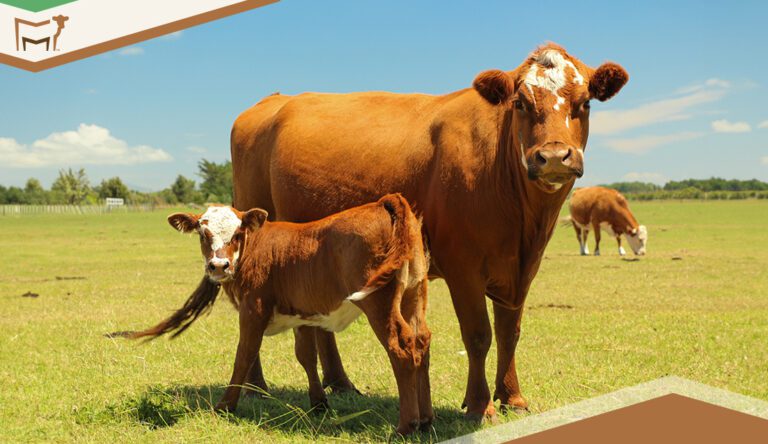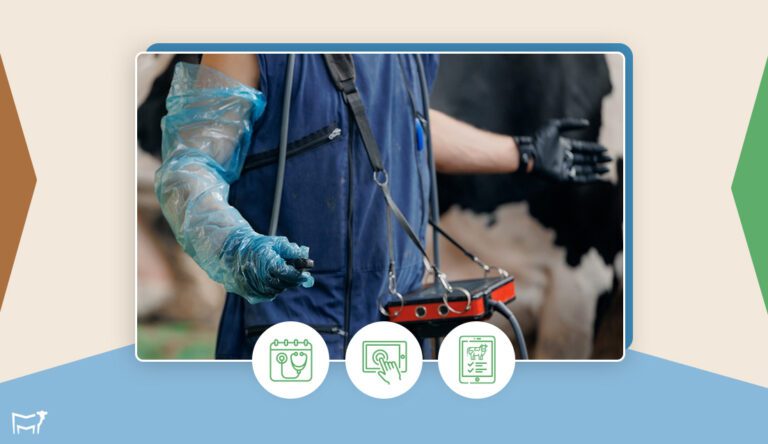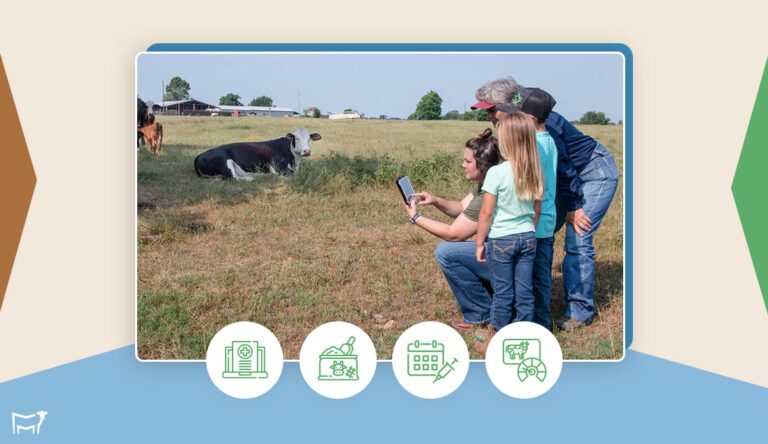5 Essential Areas to Focus on During Cattle Pregnancy

Cattle pregnancy is an important part of raising livestock, affecting both the health of your herd and your farm’s success. Whether you’re new to cattle farming or have been at it for years, knowing how to handle this process can make a big difference. While nature takes care of much of the work, being prepared and aware of what to look for can help you support your cows during pregnancy. By learning about reproductive health and monitoring your cows, you can create a healthy environment for both the mother and her calf.
In this blog we’ll discuss five essential aspects to take care of during cattle pregnancy:
Accurate Pregnancy Detection Methods
Accurate and timely pregnancy detection is crucial for effective herd management. The three most common methods are rectal palpation, ultrasound, and blood testing.
Rectal palpation can detect pregnancy as early as 35-45 days after breeding. An experienced veterinarian can estimate the stage of pregnancy and approximate calving date. This method is cost-effective but requires skill to avoid harming the fetus.
Ultrasound can detect pregnancy even earlier, from 13-21 days post-breeding. It’s less invasive than palpation and can determine fetal age, viability, and sex. However, the equipment is expensive and requires specialized training.
Blood testing detects pregnancy-specific proteins from 28 days after breeding. It’s non-invasive and can be performed by farmers, but results take time as samples must be sent to a lab.
- Schedule Regular Checks: For optimal results, conduct pregnancy checks at 30-45 days post-breeding to allow for timely management decisions.
- Use Technology: Consider investing in ultrasound equipment for early detection and to monitor fetal health, especially if you have a large herd.
- Keep Detailed Records: Maintain accurate breeding and testing records to track the reproductive performance of each cow. This helps identify patterns and improve future breeding strategies.

Nutritional Management During Pregnancy
Proper nutrition during pregnancy is essential for the health of both the cow and the developing calf. Nutritional needs change throughout gestation, with the most significant increase occurring in the last trimester.
In early pregnancy, maintain the cow’s body condition score (BCS) between 5 and 7 on a 9-point scale. Avoid overfeeding, as excess fat can lead to calving difficulties.
During mid-gestation, focus on meeting maintenance requirements and supporting moderate fetal growth. Increase energy and protein intake slightly.
In late gestation, the fetus grows rapidly, and the cow’s nutritional needs increase significantly. Boost energy, protein, and mineral intake, especially calcium and phosphorus for skeletal development.
- Adjust Rations: Increase energy and protein intake during the last trimester when fetal growth is rapid. Use high-quality forage and consider adding grain or protein supplements.
- Monitor Body Condition: Regularly assess the body condition score of pregnant cows. Aim for a score of 5-7 before calving. Cows that are too thin or too fat can face complications during calving.
- Provide Mineral Supplements: Ensure that pregnant cows receive adequate minerals, especially calcium and phosphorus, which are crucial for fetal development. Consider using a mineral block specifically formulated for pregnant cattle.
- Hydration is Key: Ensure access to clean, fresh water at all times, as hydration is vital for nutrient absorption and overall health.
Health Monitoring and Vaccinations
Regular health monitoring and a comprehensive vaccination program are crucial for maintaining the well-being of pregnant cows and their unborn calves.
Implement a consistent health check routine, including regular veterinary visits. Monitor for signs of illness, parasites, or nutritional deficiencies. Pay special attention to udder health to prevent mastitis.
- Create a Vaccination Schedule: Work with your veterinarian to establish a vaccination schedule that aligns with the pregnancy stages. Vaccines for BVD, IBR, and leptospirosis should be administered before breeding or during early gestation.
- Implement a Biosecurity Plan: Protect your herd from diseases by isolating new animals and maintaining strict biosecurity protocols. This is especially important for pregnant cows, as they are more susceptible to stress and illness.
- Post-Vaccination Monitoring: After vaccinations, monitor cows for any adverse reactions, particularly in pregnant animals, to ensure their well-being.
Preparing for Calving
Preparing for calving during cattle pregnancy is a crucial process that requires careful planning and attention to detail. Farmers and ranchers must start preparations well in advance of the expected calving date to ensure the health and safety of both the cow and her calf.
- Accurately Track Key Dates: One of the first steps in preparation is to accurately track breeding dates and calculate the expected calving time frame. This allows for proper management of the pregnant cow’s nutrition and care leading up to birth. As the cow enters her third trimester, her nutritional needs increase significantly, and her diet should be adjusted accordingly to support the growing calf and prepare her body for lactation.
- Safe Environment: Create a clean, dry, and safe calving environment: This involves setting up a separate calving area or pasture, which should be easily accessible and protected from harsh weather conditions. The area should be regularly cleaned and supplied with fresh bedding to minimize the risk of infection for both the cow and newborn calf.
- Calving Kit: Farmers should also prepare a calving kit well in advance. This kit typically includes essential items such as obstetrical gloves, lubricant, clean towels, iodine for naval disinfection, colostrum supplements, and basic medical supplies. Having these items readily available can be crucial in case of any complications during the calving process.
As the expected calving date approaches, increased monitoring of the pregnant cow becomes necessary. Signs of impending labor include udder enlargement, relaxation of the pelvic ligaments, and behavioral changes such as restlessness or isolation from the herd. Many farmers implement a system of frequent checks or even use technology like calving cameras to keep a close eye on their pregnant cows.
Accurate Pregnancy Detection Methods
Record keeping for pregnant cows is a critical aspect of effective herd management. Accurate and detailed records allow cattle producers to make informed decisions, improve herd productivity, and ensure the health and well-being of their animals.
One of the most important records to maintain is breeding data. This includes the date of breeding or artificial insemination, the identity of the bull or semen used, and any observed heats or returns to estrus. These details help in predicting due dates and planning for calving season.
Throughout pregnancy, it’s crucial to keep track of each cow’s health status. This includes:
- Regular body condition scoring, which helps in adjusting nutritional programs as needed.
- Vaccination records are also vital, ensuring that pregnant cows receive appropriate immunizations at the right times to protect both the cow and her developing calf. Nutritional records play a significant role in managing pregnant cows.
- Tracking feed types, amounts, and any supplements given helps in maintaining optimal health and preparing the cow for lactation. This is particularly important in the last trimester when nutritional requirements increase substantially.
- Health records should include any treatments administered, such as deworming or other medications. It’s essential to note not only what was given but when, as some treatments may need to be avoided during certain stages of pregnancy.
As calving approaches, recording any signs of impending labor becomes important. This might include changes in behavior, udder development, or physical signs of preparation for birth. After calving, it’s essential to record the birth date, any assistance required during delivery, the calf’s sex, birth weight, and overall health status. This information is valuable for future breeding decisions and for monitoring the performance of different genetic lines within the herd.
For multi-year analysis, maintaining historical records of each cow’s previous pregnancies, calving ease, and calf performance can provide insights into individual cow productivity and help in making retention or culling decisions.
Record Keeping for Pregnant Cows

Record keeping for pregnant cows is a critical aspect of effective herd management. Accurate and detailed records allow cattle producers to make informed decisions, improve herd productivity, and ensure the health and well-being of their animals.
One of the most important records to maintain is breeding data. This includes the date of breeding or artificial insemination, the identity of the bull or semen used, and any observed heats or returns to estrus. These details help in predicting due dates and planning for calving season.
Throughout pregnancy, it’s crucial to keep track of each cow’s health status. This includes:
- Regular body condition scoring, which helps in adjusting nutritional programs as needed.
- Vaccination records are also vital, ensuring that pregnant cows receive appropriate immunizations at the right times to protect both the cow and her developing calf. Nutritional records play a significant role in managing pregnant cows.
- Tracking feed types, amounts, and any supplements given helps in maintaining optimal health and preparing the cow for lactation. This is particularly important in the last trimester when nutritional requirements increase substantially.
- Health records should include any treatments administered, such as deworming or other medications. It’s essential to note not only what was given but when, as some treatments may need to be avoided during certain stages of pregnancy.
As calving approaches, recording any signs of impending labor becomes important. This might include changes in behavior, udder development, or physical signs of preparation for birth. After calving, it’s essential to record the birth date, any assistance required during delivery, the calf’s sex, birth weight, and overall health status. This information is valuable for future breeding decisions and for monitoring the performance of different genetic lines within the herd.
For multi-year analysis, maintaining historical records of each cow’s previous pregnancies, calving ease, and calf performance can provide insights into individual cow productivity and help in making retention or culling decisions.
Ditch Traditional Systems and Turn to Digital Solutions
While traditional paper-based systems can work for record keeping, many cattle producers are turning to digital solutions for more efficient and comprehensive record management. This is where software like CattleMax come into play.
CattleMax offers a user-friendly platform to track all your cattle reproduction records in one place. From heat detection to breeding records, and pregnancy checks to calving data, this software simplifies the entire process. Here’s why CattleMax is the ideal tool for managing your herd’s pregnancies:
- Complete Breeding Records: Easily record natural service, AI, and ET breedings.
- Intelligent Pregnancy Tracking: Automatically calculate due dates and manage pregnancy check results.
- Pasture Exposure Tracking: Quickly record bull turn-ins and track exposures for all females in a pasture.
- Powerful Reporting: Generate comprehensive reports to make informed decisions about your breeding program.
With CattleMax, you can easily input and access breeding records, health data, and calving information. The software allows for quick entry of pregnancy check results, expected calving dates, and individual cow histories. Start your free trial of CattleMax today or schedule a demo with our rancher-based team.

Jacqueline
Jacqueline, a true Wyoming native, was raised on her family's ranch just north of Cheyenne. Her journey led her to the University of Wyoming, where she earned a Bachelor of Business Administration in Management and Marketing. She and her husband, Darrell, manage a thriving herd of commercial Angus cattle.

